Abstract
The global outbreak of COVID‐19 and subsequent lockdowns raises serious economic concern and havoc worldwide. This article tries to provide an economic perspective of COVID‐19 in India using some statistical figure of economic indicators. Analysis is based on the data collected for macro‐economy, travel & tourism, transportation, stock market, human capital and trade. Finding revel that India could experience a health debacle at present and excruciating economic contraction in the near future if the government is unable to execute a proper policy framework. Based on the discussion, a few policy suggestions have been presented to counter both health and economic crisis.
1. INTRODUCTION
In January 2020, World Bank argues that growth in almost all emerging markets and developing economies regions have been weaker than expected due to the global trade tension, sharp downturn in the major economy and financial disruptions. They suggest that there is a need to rebuild macro‐economic policy space, pursue decisive reform to bolster governance and business climates, improve tax policy, promote trade integration and rekindle productivity growth while protecting vulnerable groups (World Bank, 2020). But, the whole scenario has changed, not because of inappropriate policy intervention, it is because of Coronavirus diseases 2019 (COVID‐19). China reported the first case to the World Health Organisation (WHO) country office in China on 31st December 2019. The WHO on 30 January 2020, has declared it, as a public health emergency of international concern and on 11 March 2020, COVID‐19 has been declared as a pandemic by the same organisation. The spread of the virus and its impact on mortality and morbidity can be assessed by the fact that it reached 697,244 confirmed cases worldwide and 33,257 deaths across the 204 countries and territories (WHO, 31 March 2020) and it is going to be more severe because the trend is rising continuously.
The COVID‐19 outbreak is first and foremost a human tragedy, affecting hundreds of thousands of people. Thus, many countries have been lockdown and restrict their economic agents to mobilise from one country to another country and even within the country due to the communicable COVID‐19. It is having a growing impact on the global economy and unfortunately, the global health crisis becomes a global economic crisis due to the cancel of flights, restriction on labour mobility and volatility in stock markets, fall in oil prices, and so on. For vulnerable families, loss of income due to an outbreak can translate to spikes in poverty, missed meals for children and reduced access to healthcare for beyond COVID‐19.
Surveys of China's manufacturing and services sector plunged to record lows in February (Business News, 2020), automobile sales sank a record 80% (Bloomberg News, 2020), and China's exports fell 17.2% (Bermingham, 2020) in January and February. As COVID‐19 spreads, China's economic recovery will be challenged as demand from other countries drops as they cope with the virus. Although the outbreak appears to have slowed in China, COVID‐19 and its impacts have gone global. The United States, China, Japan, Germany, Britain, France and Italy have contributed 60% of world supply and demand [gross domestic product (GDP)], 65% of world manufacturing, and 41% of world manufacturing exports (Baldwin & di Mauro, 2020) but unfortunately, these are in the top‐10 most affected countries by COVID‐19 except Japan (WTO, 28 March 2020). Annual global GDP growth is projected to drop one‐half a percentage point (from 2.9 to 2.4%) in 2020, with growth possibly even being negative in the first quarter of 2020 (OECD, 2020). In this addition, the head of the IMF (Kristalina Georgieva) said the World economy had entered a recession “as bad or worse” than the global financial crisis of 2008–2009 (Elliott, 2020).
This global outbreak reaches to more than 200 countries and India is also one of them. The cases of the virus in India has been rising day by day and upraised the concerns regarding its economic consequences (refer to Figure 1). India is one of the fastest growing economy and the fifth largest economy of the world (Economic Survey 2019‐20, 2020). The GDP value of India represents 2.31% of the world economy in 2019 (Treding Economics, 2020) and GDP based on PPP, India represent 8.27% of the world economy in 2020 (IMF, 2019). However, many electronic media (BBC, 2019; Subramanian, 2019) and economist (Subramanian & Felman, 2019) was claiming that India is facing the problem of economic slow‐down, the decline in demands, rise in unemployment, decline in consumption expenditure especially in the rural area and so on. With the downturn of economic status, India has now stuck in the spread of COVID‐19 and the country has been lockdown for 21st days till 14 April 2020. Where, top 10 states of India, which are highly affected by COVID‐19 has contributed 70% of India's state GDP and this outbreak could lead to rapid fall in growth performance.
FIGURE 1.
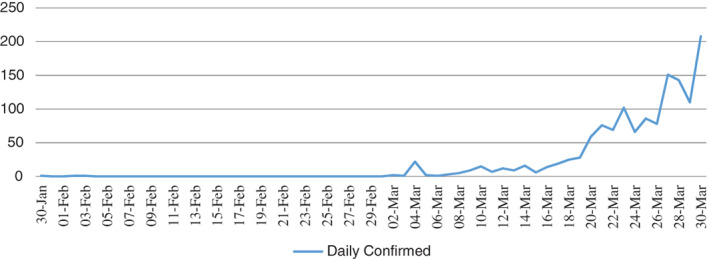
Daily confirmed cases of COVID‐19 in India. Source: www.covid19india.org
Concerns regarding the health facilities are one of the fundamental to this pandemic and India ranked far below in health facilities as compared to world average. India spends very few amounts in health sector in the yearly budgets and this health crisis severely rejuvenates the lacking. In the union budget of 2020–2021, the budget allocation for heath sector is just 67,484 core rupees which is approximately 1% to the GDP and far below to targeted 2.5% (Jayakumar, 2020). India has one doctor per 1,457 people and one nurse to 675 people as compared to the WHO norms of 1:1,000 and 3:1,000 respectively (Business Standrad, 2019). Per person health expenditure India is just 75$ where 70% of it consist of private spending and 30% of its public spending (Asrar, 2017). Thus the poor health facilities in India are clearly visible form the above discussion and this pandemic will be a challenging time for Indian health sector. This heath emergency has a direct link with economic crisis as any economy cannot survive without healthy and active economic participation of the people. Therefore, the present situation ring the alarming bell to the Indian government and through this study, we try to provide some possible economic impact of COVID‐19.
Mishra (2020), on behalf of Business Today (refer to Table 1) recently estimated the expected loss in the component of Indian GDP due to the 21 + 7 (additional days of the operating cycle before a material or service can be back to operations days) nationwide lockdown. The loss could be approximately 8.76 lakh crore rupees of gross value added (GVA) in total, where highest loss may be encountered in financial, real estate and professional service sector with 2.81 lakh crore followed by trade, hotel and transport sector with 2.42 lakh crore.
TABLE 1.
Estimated loss in GVA and its components
| Sector | GVA (Rs. in lakh Cr.) | % to total | Disruption severity | Loss estimated (Rs. in lakh Cr.) |
|---|---|---|---|---|
| Agriculture, forest and fishing | 27.76 | 16 | ||
| Industry | 37.08 | 22 | ||
| Mining and quarrying | 4.1 | 3 | Complete | 0.31 |
| Manufacturing | 28.18 | 16 | Near complete excluding medicines etc. | 2.16 |
| Electricity, gas, water supply and other utilities | 4.8 | 3 | ||
| Services | 107.15 | 62 | ||
| Construction | 13.76 | 8 | Complete | 1.06 |
| Trade, hotel, transport, communication and services relating to broadcasting | 31.51 | 18 | Near complete excluding broadcasting | 2.42 |
| Financial, real estate and professional services | 36.66 | 21 | Near complete expect banking, healthcare services | 2.81 |
| Public administration, defence and other services | 25.22 | 15 | ||
| Total | 171.99 | 100 | 8.76 |
Abbreviation: GVA, gross value added.
Source: Business Today (2020).
Thus, the time has come when policymakers and government bodies should take deep agitation about to recover people from the tragedy of COVID‐19 and, aware and take necessary actions to prevent probable economic damages. Based on the above discussion, we develop two main objectives in this study, firstly, we accommodate the theoretical linkages to evaluate potential broad channels through which COVID‐19 could impact an emerging economy like India. And secondly, we are focusing on the economic consequences of COVID‐19 on Indian economy with a present assessment of economic outcomes.
2. THE ECONOMIC LINKAGES
COVID‐19 does not only bring health sector crisis to the world but also assign economic crisis. Restriction on trade, travel and labour mobility will largely create demand and supply shocks. Developing countries like India have severe consequences for employment as 81% of employment is informal in nature (ILO, 2018). Nation wise lockdown has a high economic impact on the lower sections of the society which mostly are daily earner and engaged in the informal economy. Nearly 90% of the workforce in informal sector has survived with no minimum wage or any kind of social security (Sharma, 2020). Even after the unorganised workers social security act (2008), only 5–6% got enrol for social security. According to Periodic Labour Force Survey of 2017–18, 71.1% had no job contract, 54.2% are not eligible for paid leave and 49.6% has no social security (Mohanty, 2019).
The exact span and deepness of the crisis are not known right now and time will reveal the real picture. However, economist like Evans and Over (2020) provides some potential economic channel of COVID‐19 for low and middle‐income countries. We find their arguments and theoretical linkages are applicable for India also. We presented the broad economic channels in the Figure 2 and extended their theoretical linkages by including the confidence channel inspired by Boone (2020). The confidence of the consumer/investor is mostly influenced by macro‐economic uncertainty. The long‐run effect of COVID‐19 is mainly run from the health, education and infrastructure sector. Sickness and mortality will results in loss in income and human life. In a same fashion, the government mandates and institution decision will impact both the education and infrastructure development which have long‐run consequences.
FIGURE 2.
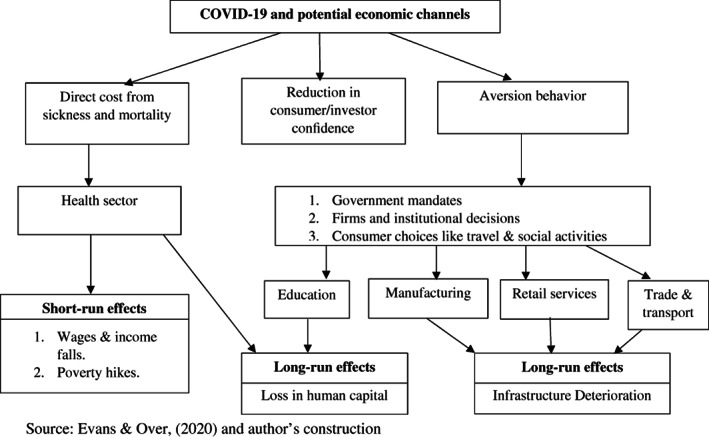
Broad channels of short‐term and long‐run economic impact of the COVID‐19. Source: Evans and Over (2020) and author's construction
After the discussion of the theoretical linkages, following sections devoted to explain economic situations in India at national and sub‐national level with the use of recent data series.
3. MACRO‐ECONOMIC IMPACTS
The macro‐economic impacts of COVID‐19 on India's national and sub‐national level are uncertain. India is already running through economic distress after the adoption of demonisation in 2016 (India‐Today, 2020). After the emergence of COVID‐19, people regarded it as a double hit to the Indian economy. Moody's (2020) 1 has cut down the growth projection for India by 1.2% in FY‐2020. Looking at the recent spread of the virus in India, it is highly reported in the states like Maharashtra, Kerala, Delhi and Uttar Pradesh. Through this section, we try to provide an existing condition of Indian economy and early estimate of economic impacts.
In Table 2, we have reported the top 10 Indian states with their respective GDP sizes. The data for 2017 clearly show that these states contribute more than 70% of the total state GDP and unfortunately most of these states are highly affected by COVID‐19 (31 March 2020). Complete lockdown of the country will hamper every state's growth performance. The fall out mostly encountered from the industry, manufacturing, construction and real estate sector. And the impact may be long‐lasting contagion effect due to interstate and inter‐sectoral linkages. Restriction on transportation and labour mobility mostly halter the economic activity initially and demand in the economy in the later period. The economic crisis, as far now, predicted as supply shock to the economy. In long‐run, supply shock also has the potential to create demand shock.
TABLE 2.
Gross state domestic products and confirmed cases
| State/UTs | GSDP | Relative share | COVID‐19cases (as on 30 March 2020) |
|---|---|---|---|
| Maharashtra | 1,942,768.951 | 14.67 | 238 |
| Tamil Nadu | 1,116,333.855 | 8.43 | 67 |
| Gujarat | 1,089,811.435 | 8.23 | 70 |
| Uttar Pradesh | 1,079,879.35 | 8.15 | 96 |
| Karnataka | 1,037,729.384 | 7.84 | 91 |
| West Bengal | 711,408.0575 | 5.37 | 22 |
| Rajasthan | 633,277.7348 | 4.78 | 79 |
| Andhra Pradesh | 594,840.79 | 4.49 | 23 |
| Telangana | 559,491.54 | 4.22 | 77 |
| Delhi | 554,908.2255 | 4.19 | 97 |
Source: MOSPI and www.covid19india.org.
4. TRAVEL AND TOURISM
The pandemic raises the concerns regarding travel and tourism industry as the almost entire world is now in isolation. According to the Ministry of Tourism, India ranked 25th globally and seventh in Asia and the Pacific in respect of international tourist arrivals in 2018. The nationwide lock‐down will restrict both international and domestic tourist movement. Table 3 indicates that there were already 5.2 million foreign tourist arrivals (FTA) in India till June 2019 and it implies that FTA is much higher as compared to the same period with 2017 and 2018. Data on domestic tourists in the Table 3, suggest that there were 1,657.55 and 1,854.93 million tourist in 2017 and 2018 respectively. Tourism creates demand in the economy and employment. Month wise data on foreign exchange earnings (FEE) reveal that India earned 14.13 billion U.S. dollars in the period January to June in 2019, and have the potential to earn 14–15 billion dollars in the later period of that year. In case of existing 21 days, lockdown could lead a loss of 1.5–2 billion dollars from FEE.
TABLE 3.
FTA, FEE and domestic tourist
| FTA | FEE | |||||
|---|---|---|---|---|---|---|
| Month | 2018(p) | 2019(p) | 2018 | 2019(p) | Year | Domestic tourist (MN) |
| January | 10,45,035 | 11,03,380 | 2.791 | 2.557 | 2012 | 1,045.05 |
| February | 10,49,255 | 10,87,694 | 2.76 | 2.515 | 2013 | 1,142.53 |
| March | 10,21,530 | 9,72,866 | 2.648 | 2.318 | 2014 | 1,282.8 |
| April | 7,45,051 | 7,71,353 | 2.379 | 2.456 | 2015 | 1,431.97 |
| May | 6,06,522 | 6,10,590 | 1.889 | 1.968 | 2016 | 1,615.39 |
| June | 6,83,928 | 7,21,015 | 2.124 | 2.299 | 2017(p) | 1,657.55 |
| Total (Jan–June) | 51,51,321 | 52,66,898 | 14.591 | 14.113 | 2018(p) | 1,854.93 |
Abbreviations: FEE, foreign exchange earnings; FTA, foreign tourist arrivals.
Source: India Tourism Statistics.
Note: (p) Indicates provisional data.
The Indian tourism industry is a highly potential and respect of size, its share is 5.06% of GDP (see Table 3) people are directly and indirectly benefited from the tourism sector through its wide linkages with other sector and economic activities. Table 3 shows that the share of tourism in total employment is 12.13% in 2017–2018 and rises to 12.75% in 2018–2019. The direct and indirect employment provided by this sector also rises to 5.56–7.19% in 2018–2019. The total number of employment generated in tourism sector inclined from 80.63 to 87.5 million in 2018–2019. The sudden lockdown has a severe impact on income and livelihood of this large amount of people.
5. HUMAN CAPITAL
Widespread COVID‐19 has an important implication on education system in India. Gross enrolment rate is highest in case of primary, upper primary and elementary level of education (refer to the Table 4) and shut down of all schools will lead to a huge amount of student to sit at home. The role of technology in providing remote learning is very much limited and uncertain in India. Close down of schools will highly impact educational outcome without remote educational facilities.
TABLE 4.
Gross enrolment ratio in India
| Year/level | i‐v | vi‐viii | i‐viii | ix‐x | xi‐xii | ix‐xii | Higher |
|---|---|---|---|---|---|---|---|
| 2013–2014 a | 101.4 | 89.3 | 97 | 76.6 | 52.2 | 62.5 | 23 |
| 2014–2015 a | 100.1 | 91.2 | 96.9 | 78.5 | 54.2 | 65.3 | 24.3 |
| 15–2016 a | 99.2 | 92.8 | 96.9 | 80 | 56.2 | 68.1 | 24.5 |
Source: Educational statistics at a glance (2018).
Indicates provisional data.
6. TRADE
After the great trade collapse in 2008–2009 (Baldwin & Tomiura, 2020), COVID‐19 again draw attention regarding its possible impact on global trade. Close down of the world economy will largely hit the trade sector. The impact will be large to those countries which growth is mostly trade‐driven. Baldwin & di Mauro, 2020 argued that, global trade could experience a fall of 1.4% due to this pandemic in the first half of 2020. India's contribution to global trade is 2.1% in 2017 (Ministry of Commerce & Industry, 2019) and ranked 7th in imports and 16th in exports. Both the demand and supply shock will hit the global trade and India's trade as well. Recent trend in exports and imports show the fluctuation in the first 2 months of 2020 (refer to Figures 3 and 4). Due to the lockdown, it becomes obvious that both exports and imports will experience a drastic decline in March and the upcoming months of 2020. However, the duration is unclear today and will depend upon the lethality of the virus and actions taken by the governments.
FIGURE 3.
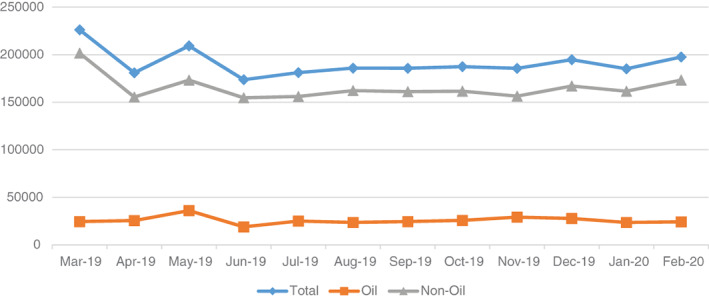
Trend in exports. Source: http://www.epwrfits.in/
FIGURE 4.
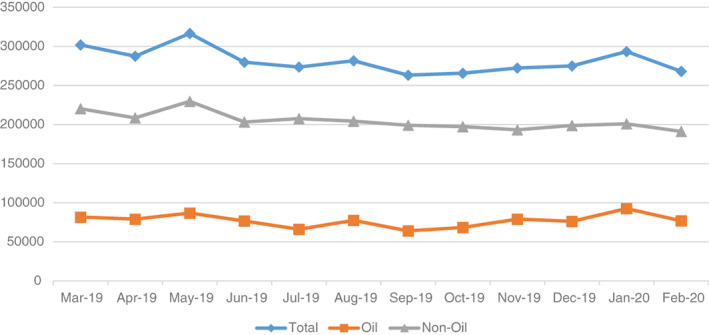
Trend in imports (in crore). Source: http://www.epwrfits.in/
7. TRANSPORTATION
An important sector that usually affected instantly by lockdown is the transportation sector. Disruption in the transport system quickly affecting the demand in the service sector that is crucial for micro, small and medium enterprises (MSME) which are more fragile to market demands (Bouey, 2020). Considering three modes of transportation‐aviation, railway and road, India is earning huge revenue from the transportation sector. Shut down of both public and private mode of transportation will directly affect the demand and supply in the economy.
The aviation sector in India is already in a financial distress situation as national and many private air carriers are in the loss for a long time. In January 2020, airways carry 12.78 million domestic passengers and from Table 5 it can be seen that India has earned 29,834.9 and 27,648.5 million rupees in the year 2017–2018 and 2018–2019 respectively from international airlines and flight passing through Indian air zone. Close down of aviation sector nationally and internationally will reduce the revenue sources for the entire world and India as well.
TABLE 5.
Airline earnings, toll fee and railway earnings
| Year | Airline a | Toll fee | Month | Railway earnings |
|---|---|---|---|---|
| 2016–2017 | 25,094.2 | 69,379.2 | Nov, 2019 | 45,389.5 |
| 2017–2018 | 29,834.9 | 86,306.9 | Dec, 2019 | 42,330.5 |
| 2018–2019 | 27,648.5 | 91,876.7 | Jan, 2020 | 47,926.2 |
Note: All figures are in million rupees.
Revenue earned from international airlines and flights passing through Indian Air Zones in India.
The Indian railway is another important mode of domestic transportation and earned a healthy amount from passenger and goods due to its wide connectivity. Recent data indicates that in January 2020, India railways earn approximately 47,926.2 million rupees and these earning are very much sustainable (refer to Table 5). Data trend indicate the fact that railways have to suffer an enormous amount due to the lockdown.
India's road network is recognised to be one of the largest in the world which covers 5.8 million kilometres which shares 64.5% of goods and 90% of the passenger commute (Indian Road Industry Report, 2019). These figures recognised the roads as a lifeline of India's transportation. One mode of revenue generation from the road is the toll fee and annual data on toll fee from national highway reveal that India has earned 91,876.7 million rupees in 2018–2019. This is one way of revenue generation and many other sources are also there, like – vehicle tax, fines and so on, therefore the shutdown will impact the revenue collection from road transport hugely.
8. STOCK MARKETS
Stock markets mostly behave accordingly with the people confidence and market conditions. Capital market across the world witnessing high volatility due to the outbreak of the virus. In the middle of February 2020, India's share market reports a remarkable downfall in case of Sensex and Nifty both (refer to Figure 5). After 3rd March 2020, this fall is more rapid. Without proper policy incentive and reduction in the cases of COVID‐19, it will be very hard to bring investor confidence in the market.
FIGURE 5.
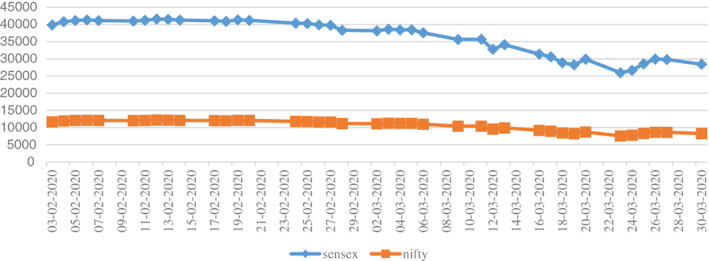
Trend in stock market. Source: www.in.finance.yahoo.com
9. CONCLUSIONS AND SUGGESTIONS
This article tries to assess the economic condition of India with some statistical figures and provide the theoretical linkages of pandemic by which economy suffers. With the use of some indicators on Indian economy such as state GDP, travel & tourism, trade, human capital, transportation and stock market, this study assess the present economic conditions. Recent trend in all the sectors of economy, suggest that there could be worst situation for India if the government unable to take appropriate policy measures.
Based on the above backdrop, there are two things, which government should take serious concern on the priorities basis, first, improving the healthcare services along with the health infrastructures as per the requirement of epidemic. The following remarks may help:
Create ventilators through moderate the hotels just like Indian government moderating the coaches of passenger rail.
Promote the factories for more production of health accessories like mask, hand wash, sanitizer and so on. Encourage other factories which are producing similar types of product and those, who can be easily modified.
The government should provide free test of COVID‐19 disease as private sector is charging 4,000–4,500 rupees per person. These charges discourage the venerable groups from the voluntary check‐ups and this could turn out to be severe for COVID‐19 spread.
The government should ensure safety, security and welfare of the front‐line workers who at the high risk and should provide monetary incentives. Government should also promote the members of “Anganvadi,” ASHA and other local governing body for the distribution of basic health accessories and the awareness of people.
And second, provide the economic assistance and incentive to the establishment of the economy in present and more likely in future through:
Distribution of cash transfers to the informal workers through geographical targeting and this can be done by the local administrative units.
Government should provide ecosystem to maintain forward and backward linkages of MSME and other exempted sectors along with special packages for MSME through moratorium of payments like bank loan, GST and others payments. This will ensure MSME to continue economic activity and employment.
Increase the scale of amount of direct benefit transfer like Jan Dhan Yojana, MGNREGA, PM‐Kisan and pension scheme along with recapitalisation of banks which will revive the demand in the economy. There should also need to temporarily increase the quantity of food distribution through the public distribution system (possibly free of cost) to ensure the food security of the vulnerable groups.
Lockdown of “Mandies” will create difficulties in selling Rabi crops in India and farmers have to bear the most losses. Thus proper functioning of “Mandies” and provision of minimum support price should be required for the survival of 58% population whose livelihood is based on agriculture.
Above all, the government should increase the productive social sector expenditure without any consideration of fiscal deficit.
ACKNOWLEDGMENT
the author's like to acknowledge the blind reviewers for their productive comments and a special thanks to Prof. A. K. Gaur (department of economics, BHU) and Shruti Shuvam (IIT, Roorkee) for their encouragements and supports.
Biographies
Manish Kumar Singh is a research scholar at Department of Economics, Banaras Hindu University, Varanasi, India and a former Visiting Scholar of Indira Gandhi Institute of Development Research, Mumbai. He is working in the area of development economics with special focus on the relationship between growth, poverty, and inequality.
Yadawanananda Neog is a research scholar in the Department of Economics, Banaras Hindu University (B.H.U). He received his master's degree in economics with the specialization in econometrics from the same university in 2013–2015. His research interests are public finance, macro‐economics, growth, and energy economics.
Singh MK, Neog Y. Contagion effect of COVID‐19 outbreak: Another recipe for disaster on Indian economy. J Public Affairs. 2020;20:e2171. 10.1002/pa.2171
Endnote
REFERENCES
- Asrar, S . (2017). India's healthcare: Private vs public sector | India | Al Jazeera. Retrieved from https://www.aljazeera.com/indepth/interactive/2017/08/india-healthcare-private-public-sector-170831125534448.html
- Baldwin, R. , & di Mauro, B. W. . (2020). Economics in the Time of COVID‐19. Retrieved from www.cepr.org
- Baldwin, R. & Tomiura, E. (2020). Thinking ahead about the trade impact of COVID‐19. Economics in the Time of COVID‐19. Retrieved from www.cepr.org
- BBC . (2019). Viewpoint: How serious is India's economic slowdown? BBC News. Retrieved from https://www.bbc.com/news/world-asia-india-49470466
- Bermingham, F . (2020). Coronavirus: China's exports and imports plummet in January and February. Retrieved from https://www.scmp.com/economy/china-economy/article/3074060/coronavirus-chinas-exports-and-imports-plummeted-january-and
- Bloomberg News . (2020). China car sales drop a record 80% as virus empties showrooms. Retrieved from https://www.bloomberg.com/news/articles/2020-03-04/china-car-sales-drop-a-record-80-as-virus-adds-to-industry-woes
- Boone, L. (2020). Tackling the fallout from COVID‐19. Economics in the Time of COVID‐19. Retrieved from www.cepr.org
- Bouey, J. (2020). Assessment of COVID‐19's impact on small and medium‐sized enterprises: Implications from China. Santa Monica, CA: RAND Corporation. [Google Scholar]
- Business News . (2020). China February factory activity contracts at record pace as coronavirus bites. Retrieved from https://www.reuters.com/article/us-china-economy-pmi-factory-official/china-february-factory-activity-contracts-at-record-pace-as-coronavirus-bites-idUSKBN20N03R
- Business Standrad . (2019). India has one doctor for every 1,457 citizens. Govt | Business Standard News. Retrieved from https://www.business-standard.com/article/pti-stories/india-has-one-doctor-for-every-1-457-citizens-govt-119070401127_1.html
- Economic Survey 2019‐20 . (2020). Government of India Ministry of Finance Department of Economic Affairs Economic Division North Block New Delhi‐110001 (Vol. 1). 10.4324/9781315016702 [DOI]
- Elliott, L . (2020). Dozens of poorer nations seek IMF help amid coronavirus crisis. Retrieved from https://www.theguardian.com/world/2020/mar/27/dozens-poorer-nations-seek-imf-help-coronavirus-crisis
- Evans, D. , & Over, M. (2020). The Economic Impact of COVID‐19 in Low‐ and Middle‐Income Countries | Center For Global Development. Retrieved from https://www.cgdev.org/blog/economic-impact-covid-19-low-and-middle-income-countries
- ILO . (2018). Woman and men in the informal economy: A statistical Picture. Geneva: International Labour Office. 10.1179/bac.2003.28.1.018 [DOI] [Google Scholar]
- IMF . (2019). World Economic Outlook (October 2019) ‐ GDP based on PPP, share of world. Retrieved from https://www.imf.org/external/datamapper/PPPSH@WEO/OEMDC/ADVEC/WEOWORLD
- Indian Road Industry Report . (2019), quoted by India Brand Equity Foundation (IBEF). Retrieved from https://www.ibef.org/industry/roads-india.aspx [Google Scholar]
- India‐Today . (2020). Gold gains as Covid‐led growth fears spur safety buying. Business News. Retrieved from https://www.indiatoday.in/business/story/gold-gains-covid-led-growth-fears-spur-safety-buying-1661437-2020-03-30
- Jayakumar, P. B. . (2020). Healthcare allocation in Budget 2020 5.7% lower than last budget. Retrieved from https://www.businesstoday.in/union-budget-2020/decoding-the-budget/healthcare-allocation-budget-2020-5-7-percent-lower-last-budget/story/395265.html
- Ministry of Commerce & Industry . (2019). India's Global Trade. Retrieved from https://pib.gov.in/newsite/PrintRelease.aspx?relid=190834
- Mishra, H. H. (2020). Coronavirus in India: COVID‐19 lockdown may cost the economy Rs 8.76 lakh crore; here's how. Retrieved from https://www.businesstoday.in/opinion/columns/coronavirus-in-india-covid-19-india-lockdown-economy-cost-gdp-gva-nationwide-shutdown/story/399477.html
- Mohanty, P . (2019). Labour reforms: No one knows the size of India's informal workforce, not even the govt. Retrieved from https://www.businesstoday.in/sectors/jobs/labour-law-reforms-no-one-knows-actual-size-india-informal-workforce-not-even-govt/story/364361.html
- OECD . (2020). Coronavirus: The world economy at risk (OECD Economic Outlook), Paris: Author. 10.1787/7969896b-en [DOI] [Google Scholar]
- Sharma, Y. S. (2020). National database of workers in informal sector in the works. The Economic Times. Retrieved April 9, 2020, from https://economictimes.indiatimes.com/news/economy/indicators/national-database-of-workers-in-informal-sector-in-the-works/articleshow/73394732.cms?from=mdr
- Subramanian, A. (2019). India facing “Great Slowdown”, economy headed to ICU: Ex‐CEA. The Economic Times. Retrieved from https://economictimes.indiatimes.com/news/economy/policy/economy‐trapped‐in‐four‐balance‐sheet‐problem‐ex‐cea/articleshow/72867290.cms?from=mdr
- Subramanian, A. , & Felman, J. (2019). India's great slowdown: What happened? What's the way out? (CID Faculty Working Paper No. 370). Center for International Development at Harvard University. [Google Scholar]
- Treding Economics . (2020). India GDP | 1960–2019 Data | 2020‐2022 Forecast | Historical | Chart | News. Retrieved from https://tradingeconomics.com/india/gdp
- World Bank . (2020). Global economic prospects slow growth, policy challenges, Washington, DC: . World Bank Publication ; Retrieved from https://www.worldbank.org/en/publication/global-economic-prospects [Google Scholar]


